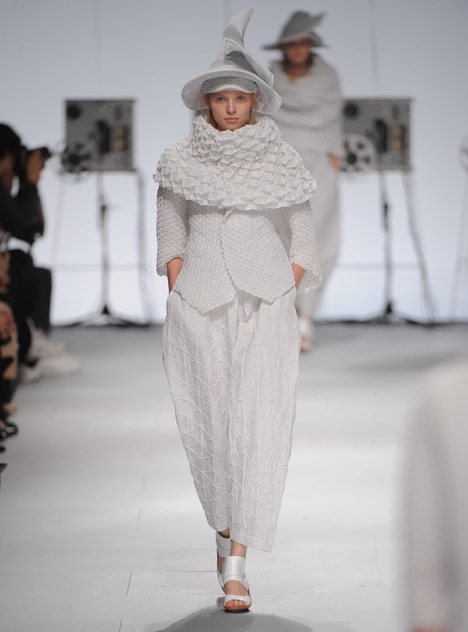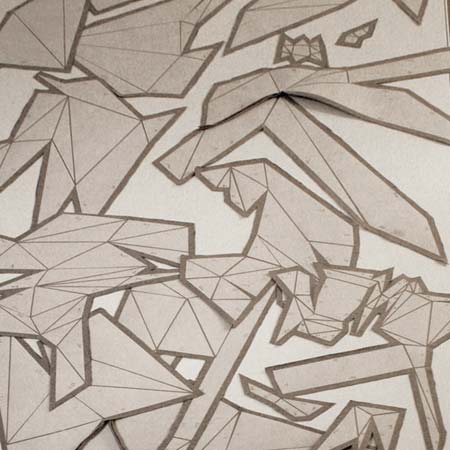The Atelier: A home for both traditional crafts and cutting-edge technologies.
07 September 2021

Over the course of this mini-series on clothes and pattern cutting, I have aimed to show that everyone can participate in fashion and express their individual style. So far, we have explored how clothes appeal to the various senses and creativity of the wearer, and how reimagining pattern blocks can lead to innovative clothing designs. The atelier is the space where makers collaborate to make clothes, going beyond their individual expertise. In this last post, we will look at the innovation different disciplines can bring to pattern cutting in this experimental space.
Flat pattern cutting has natural limitations for designing clothes for a shape as complex and dynamic as the human body. For starters, the measurements that guide pattern cutting are a mere snapshot of the human form, taken from models standing static and upright. The proportions also assume we’re perfectly symmetrical and fit nicely into the eight head theory prevailing in Western culture. In reality, our bodies are constantly moving, growing and changing. Digital technologies are providing new ways to bridge this gap between design and reality, improving the experience of wearing clothes and expanding inclusivity in sizing.

Computer simulations can mimic the interplay between materials and physical movement, providing an efficient and safe virtual environment to test fabric interactions during everyday activity. Body suits and 4D scanning technology also overcome the lack of precision in standardised measurements, capturing data on large populations of real people. Recent examples used 4D scanning to map changes that occur in an individuals’ body, too: women were tracked whilst running to create better sport bras, and pregnant women were periodically measured to predict changing clothes sizes more accurately. Finally, producing better fitting garments has become an option available to the masses, through algorithms which produce pattern blocks from personal measurements.
Aside from providing more data and simulating design solutions in a virtual environment, digital technologies can create the better-fitting garment itself. 3D printers and laser sintering can create clothes directly into the final form they will take, unrestricted by methods used to cut and join flat fabric into a 3D shape. Neri Oxman takes this process a step further: ‘the ability to vary softness and elasticity’ allows the designing of ‘not only a garment’s form but also its motion’, as a range of material properties can be printed into one continuous garment. Furthermore, virtual 3D models exist outside the restrictions of horizontal and vertical weaves which influence the draping of traditional fabrics. An unfolding function can slice a 3D model into unconventional pattern pieces, that better utilise the orientation of woven fabrics.

Clothing design has always gone hand-in-hand with traditional crafts such as needlework that add to the aesthetics of a garment. New technologies and disciplines can move beyond improving the function of a garment, and add to their aesthetic qualities, too. Issey Miyake uses computer software to come up with mathematically complex patterns to create designs that could not be achieved by handiwork alone. The designer’s 3D Stretch Seam fabric is a calculated composition of cotton and polyester weaves. When steamed, some weaves contract whilst others don’t, creating a rigid, origami-like structure. Miyake’s 132 5 project uses software common to gaming and product design to create ‘flat pack’ folded clothes with unique silhouettes and sensual experiences. Others, such as Iris van Herpen and Cecile Bahnsen, use laser cutters to create intricate and delicate designs too difficult to achieve by hand. Finally, Loewe has combined an old discipline in a new way, using ceramic plates to hold together clothes.
Pattern making resources are usually quite instructive, suggesting there is only one correct method to clothing design. I hope this series of blogs has helped you see the possible forms clothes can take in a more creative and innovative light: how clothing design is something we all engage with and experience through the simple fact of wearing clothes; how this experience differs across cultures; and that the atelier is as much a place for the material scientist, architect, and software engineer as it is for traditional crafts experts.

Fareeha Masood is a Laidlaw Scholar and History student at University College London, and has co-programmed a pattern cutting event with the Institute of Making team. Fareeha finds style inspiration in museums and magazines, but also in everyday people walking the streets and catching the tube. She’s eager to see a world where everyone has the means to express their individual style, and so is conducting research into diversity and innovation in clothing design.
Images credits: 1. About | Lucid | Collections | Iris van Herpen 2. Issey Miyake's focus is "being innovative with technology"; 3. Gathering and Ceramic Plates at Loewe - The Cutting Class; 4. The T-shirt Issue by Mashallah Design & Linda Kostowski